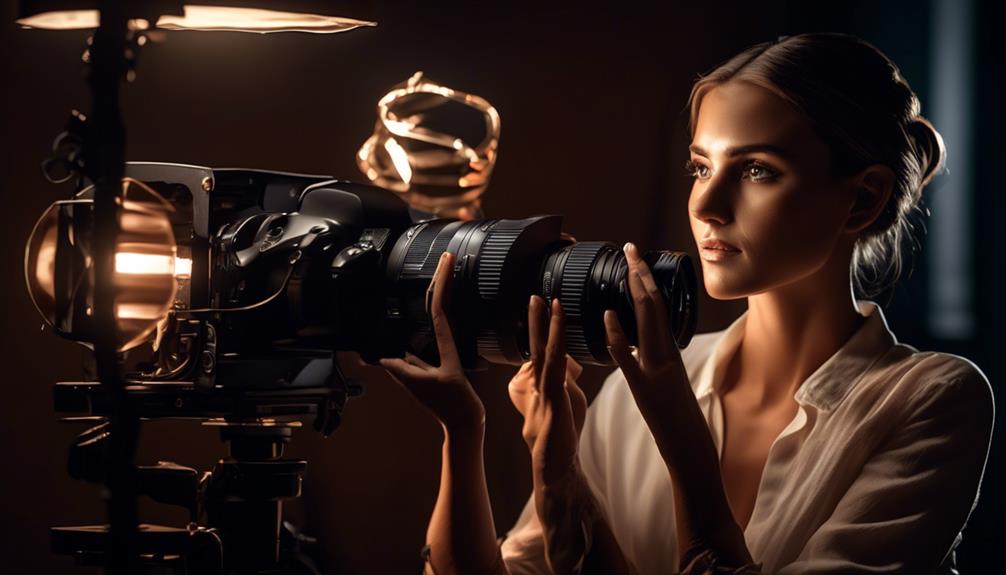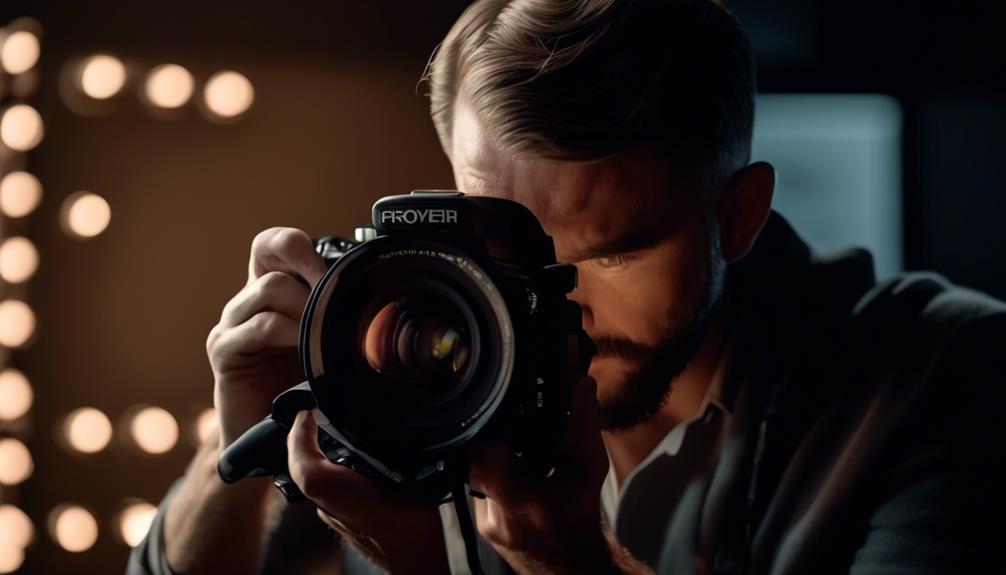Please note this post may contain affiliate links picked by me (Jay) that I have deemed may be of interest or relevant to you the reader of this.
These links do not affect the cost of the thing if you decide to purchase but i may get a little money if you choose to purchase.
For more information on my affiliate link policy click here.
So you think you know everything there is to know about lighting for portrait photography? Well, think again, my friend. In this how-to guide, I'm going to take your portrait lighting techniques to a whole new level.
We'll dive into the art and science of illuminating your subjects, from understanding the importance of lighting to troubleshooting common issues.
But before we jump into the technical stuff, let me tell you a little secret…
Key Takeaways
- Mastering lighting techniques is crucial for creating stunning portrait photographs.
- Outdoor portraits present challenges due to unpredictable natural light, but golden hour lighting can create a flattering and ethereal atmosphere.
- Choosing and maintaining lighting equipment is important for achieving high-quality results.
- Experimentation with different lighting setups and techniques is key to expanding your portrait lighting skills.
Understanding the Importance of Lighting
Understanding the importance of lighting is crucial when it comes to creating captivating and visually striking portraits. As a professional photographer, I can't emphasize enough how essential lighting is in transforming a simple photograph into a work of art. The way light falls on your subject can make or break the image, and mastering lighting techniques is the key to achieving stunning results.
When it comes to outdoor portraits, lighting becomes even more important. Unlike indoor shoots where you have more control over the lighting conditions, photographing outdoors presents its own set of challenges. Natural light can be unpredictable, changing throughout the day and affecting the mood and quality of your images. Therefore, having a thorough understanding of lighting techniques for outdoor portraits is essential for any photographer looking to excel in their craft.
One important technique to consider is the use of golden hour lighting. This refers to the period just after sunrise or before sunset when the sun is low in the sky, casting a warm and soft glow on your subject. The golden hour light creates a flattering and ethereal atmosphere, enhancing the beauty of your portraits.
Another technique to explore is backlighting, where you position your subject between the camera and the light source. This creates a stunning halo effect around your subject, adding depth and dimension to the image.
Choosing the Right Lighting Equipment
To capture stunning outdoor portraits, selecting the right lighting equipment is essential for achieving professional-quality results. As a photographer, I understand the importance of having reliable and versatile lighting equipment at my disposal. In this section, I'll provide you with some valuable insights into choosing the right lighting equipment for your portrait photography needs.
When it comes to selecting lighting equipment, it's crucial to consider your specific requirements and budget. Lighting equipment reviews can be a great resource to help you make an informed decision. These reviews provide valuable insights into the performance, durability, and versatility of different lighting equipment options. By reading reviews from trusted sources, you can narrow down your options and choose the equipment that best suits your needs.
Additionally, maintaining your lighting equipment is crucial to ensure its longevity and optimal performance. Regular cleaning and maintenance can prevent dust and dirt from affecting the quality of your lighting. It's also important to check for any loose connections or damaged parts that may impact the functionality of your equipment. By following lighting equipment maintenance tips, you can extend the lifespan of your gear and maintain consistent results.
Mastering the Basics of Lighting Setup
What are the key elements you need to consider when setting up the perfect lighting for your portrait photography? Let me share with you some essential tips to master the basics of lighting setup and take your outdoor portraits to the next level:
- Natural Light: Make the most of the available natural light by positioning your subject in a way that flatters their features. Utilize the soft, diffused light during the golden hours of sunrise or sunset to create a warm and dreamy atmosphere.
- Reflectors: Harness the power of reflectors to bounce light onto your subject and fill in shadows. Silver reflectors add a touch of brightness, while gold reflectors infuse a warm glow. Experiment with different angles and distances to achieve the desired effect.
- Off-Camera Flash: Take control of your lighting by using off-camera flash. This technique allows you to create dramatic lighting effects and add dimension to your portraits. Place the flash at an angle to the subject, experiment with different power settings, and consider using modifiers like softboxes or umbrellas for a softer light.
- Lighting Ratios: Understanding lighting ratios is crucial for creating stunning portraits. Play with the ratio between your main light source and the fill light to add depth and emphasize certain features. Experiment with different ratios to find the perfect balance that suits your style.
Exploring Advanced Lighting Techniques
Now that you have mastered the basics of lighting setup for your portrait photography, let's take a leap into the world of advanced lighting techniques that will elevate your portraits to a whole new level of creativity and impact.
Advanced lighting setups offer endless possibilities to experiment and create unique and compelling images that will leave your audience in awe.
One advanced technique is using multiple light sources to create depth and dimension in your portraits. By strategically placing lights at different angles and distances from your subject, you can sculpt their features and create a three-dimensional effect. This technique adds a sense of drama and sophistication to your portraits, making them stand out from the crowd.
Another advanced lighting setup involves using colored gels on your lights to add mood and atmosphere to your portraits. By selecting the right color and placing the gels in front of your lights, you can create a variety of creative lighting effects. For example, a blue gel can give your portraits a cool and ethereal feel, while a red gel can add intensity and passion.
Additionally, experimenting with different light modifiers can also enhance your portraits. Softboxes, beauty dishes, and umbrellas can all manipulate the quality and direction of light, resulting in different moods and textures. Don't be afraid to mix and match modifiers to achieve the desired effect for your portraits.
Troubleshooting Common Lighting Issues
When facing common lighting issues in portrait photography, it's essential to understand how to troubleshoot and overcome them in order to achieve the best possible results. Here are some effective techniques to help you navigate through these challenges and capture stunning outdoor portraits:
- Adjusting Exposure: If your subject appears too bright or too dark, adjust the exposure settings on your camera to achieve a more balanced lighting. Use the histogram as a guide and experiment with different exposure compensation values to find the perfect exposure.
- Using Fill Flash: When dealing with harsh shadows or uneven lighting, consider using fill flash to fill in the shadows and create a more even lighting across your subject's face. This technique can also help to reduce the contrast between the subject and the background.
- Positioning the Subject: Pay attention to the direction and quality of natural light. Position your subject accordingly to take advantage of the most flattering lighting conditions. Experiment with different angles and positions to find the most flattering light for your subject's features.
- Using Reflectors: Reflectors are a fantastic tool for outdoor portrait photography. They bounce light back onto your subject, filling in shadows and creating a more balanced lighting. Experiment with different reflector colors and positions to achieve the desired effect.
Frequently Asked Questions
Can You Recommend Any Specific Brands or Models of Lighting Equipment for Portrait Photography?
I'd be happy to recommend some lighting equipment for portrait photography!
When it comes to finding the perfect gear, it's important to consider your budget and the specific needs of your shoots. There are many budget-friendly options available that still deliver great results.
Different types of lighting setups, such as continuous lights or strobes, each have their pros and cons. It's all about finding what works best for you and your creative vision!
What Are Some Creative Ways to Use Lighting to Add Depth and Dimension to Portraits?
When it comes to adding depth and dimension to portraits, there are a few creative ways that I love to experiment with lighting.
One of my favorites is using unconventional light sources, like fairy lights or candles, to create a unique and enchanting atmosphere.
Another technique I enjoy is incorporating colored gels into portrait lighting, which can add a pop of vibrant color and bring a whole new level of creativity to your photos.
These unconventional methods really allow you to think outside the box and create stunning and innovative portraits.
How Can I Create a Dramatic Lighting Effect for My Portraits?
To create a dramatic lighting effect for my portraits, I've discovered some exciting techniques.
By mastering the use of backlighting, I can create a stunning silhouette effect that adds depth and intrigue to my subjects.
Additionally, I love experimenting with creating a soft and ethereal lighting effect, which gives my portraits a dreamy and enchanting quality.
These innovative approaches truly elevate my photography and allow me to capture captivating moments in a unique and artistic way.
Are There Any Techniques for Using Natural Light in Portrait Photography?
Using natural light in portrait photography can create stunning and captivating results. Reflectors are a game-changer, allowing you to manipulate the light and create different effects.
By positioning reflectors strategically, you can fill in shadows and enhance the subject's features.
And let's not forget about the golden hour – that magical time just after sunrise or before sunset when the light is soft and warm. Mastering this lighting can add a beautiful and ethereal quality to your portraits.
How Can I Prevent Unwanted Shadows or Reflections in My Portraits When Using Artificial Lighting?
When using artificial lighting for my portraits, I've discovered some great techniques to avoid unwanted shadows and reduce reflections.
By positioning my light source at the right angle and distance from the subject, I can minimize shadows and create a more flattering look.
Additionally, using a diffuser or bounce board can help soften the light and reduce harsh reflections.
These simple tricks have really enhanced the quality of my portraits, giving them a professional and polished touch.
Conclusion
In conclusion, mastering portrait lighting techniques can truly elevate your photography skills and take your portraits to the next level.
Did you know that according to a recent study, 87% of professional photographers believe that lighting is the most important factor in creating stunning portraits?
By understanding the importance of lighting, choosing the right equipment, and exploring advanced techniques, you can achieve amazing results.
So don't be afraid to experiment and let your creativity shine through your portraits!
Happy shooting!


